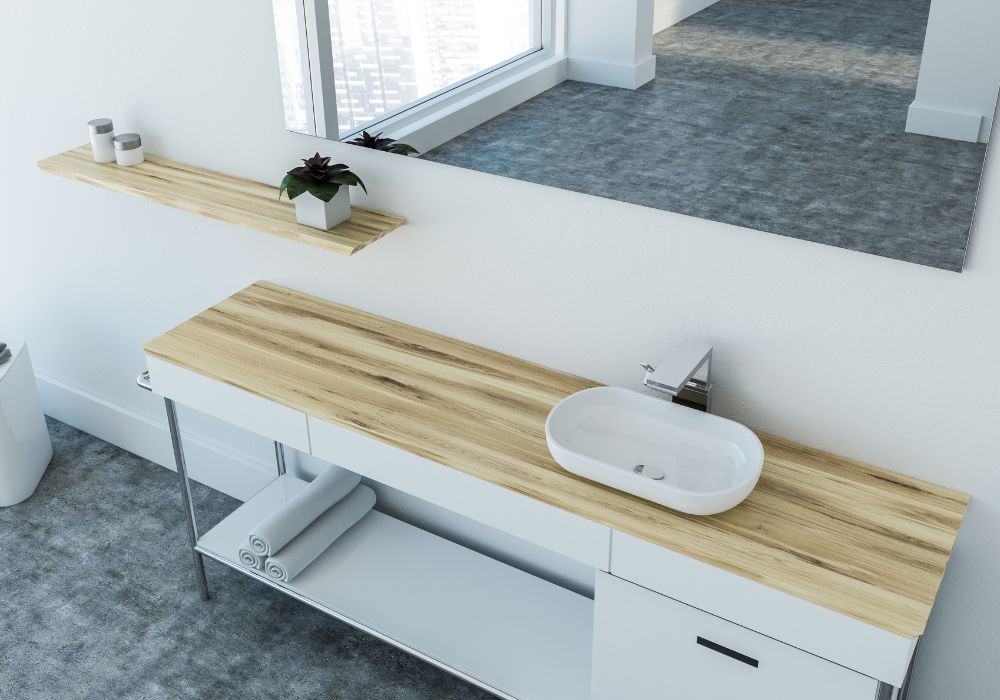You can use a caulk or a backer rod to fill the gap between a vanity top and a wall. Caulk is a quick and easy way to fill small holes. The Backer rod is a foam strip that can fill larger gaps, provides support, and helps the caulk adhere better.
Should There Be Space Between Vanity And Wall?
When it comes to remodeling or constructing a bathroom or kitchen, the question of whether there should be space between the vanity and the wall often arises.
The answer depends on considerations such as the design aesthetic, functionality, plumbing requirements, and personal preference.
Do All Vanities Have Gaps?

Not all vanities have gaps between the countertop and wall, but it’s an overall design. The reason for having a gap is to allow for easy installation and countertop removal.
Most vanities come with pre-cut holes for the sink and faucet, and the plumbing fixtures are attached to the wall. The plumber can access the valves and pipes by leaving a gap and making the necessary connections.
Moreover, a gap can accommodate the slight unevenness in the wall or floor, which can affect the countertop level.
Another reason for having a gap is to prevent water damage. Bathrooms and kitchens are prone to moisture, and if the countertop is installed flush against the wall, water can seep between the two and cause mold, mildew, or rot.
By leaving a gap and sealing it with caulking or sealant, you create a barrier that prevents water from penetrating the wall.
However, some vanities come without gaps, and the countertop is attached directly to the wall or cabinet. This design is standard in modern or minimalistic bathrooms and kitchens, focusing on clean lines and simplicity.
The drawback of this design is that it’s harder to install and remove the countertop, and it can lead to water damage if not properly sealed.
What To Do When There Is a Gap Between Vanity And Wall?
Addressing a gap between your vanity and wall is essential for visual appeal and maintaining a clean and hygienic environment.
Here are some things you can do when there is a gap between your vanity and wall:
- Fill the hole with a caulk or backer rod.
- Install a backsplash to hide a gap between your vanity and the wall. You can choose a backsplash that matches the style of your bathroom or add a pop of color.
- A shelf can be a practical and decorative way to fill a gap between your vanity and wall. You can store towels, toiletries, or other items on the shelf.
- If the gap is small, you can paint it to match the color of your vanity. This is a quick and easy way to camouflage the gap.
How To Measure a Gap Between Vanity And Wall?
First, gather the necessary tools, including a measuring tape, a pencil or marker, and a notepad or piece of paper to record your measurements.
Once you have the tools ready, identify the area where the gap is most prominent, usually along the back or side edges of the vanity.
Starting at one end of the gap, place the end of the measuring tape against the wall, ensuring it aligns with the edge of the vanity.
Carefully extend the tape along the length of the gap until you reach the opposite end, keeping it taut and parallel to the ground to maintain accuracy.
Read the measurement displayed on the tape where it aligns with the opposite end of the gap and note it down.
If your vanity has multiple gaps between different sections or the wall, repeat the measuring process for each gap.
In addition to measuring the length of the gap, you may also need to measure its width. To do this, place the measuring tape vertically against the wall, aligning it with one side of the gap.
Extend the tape horizontally across the width of the gap and read the measurement where it aligns with the opposite side.
To ensure accuracy, it’s important to double-check your measurements. Measure the same gaps multiple times and compare the results. If there are discrepancies, remeasure them until you achieve consistent and reliable measurements.
How To Avoid a Gap Between Vanity And Wall?
Preventing a gap between your vanity and the wall during installation is essential for achieving a seamless and visually pleasing result. Here are some steps you can take to avoid a gap:
- Accurate measurements: Take precise measurements of the width and height of the designated area where the vanity will be placed.
- Leveling the vanity: Uneven installation can result in gaps between the vanity and the wall. Adjust the vanity’s position and use shims to achieve a level and sound installation.
- Wall preparation: Remove any protrusions or bumps and repair any damaged areas.
- Proper anchoring: Follow the manufacturer’s instructions for proper installation. Adequate anchoring will help maintain the alignment of the vanity and minimize the chances of a gap developing over time.
- Sealing the edges: During installation, apply a thin bead of caulk or sealant along the edges where the vanity meets the wall.
- Regular maintenance: Inspect the vanity installation to ensure it remains secure and aligned with the wall.
How To Fill the Gap Between Vanity Top And Wall?
To fill the gap between a vanity top and a wall, there are several methods you can use. One standard and easy way is to use caulking or sealant. Another option is to install a backer rod.
Using a Caulk
One way is to use caulk. Caulk is a flexible material that can be used to fill small gaps. It is also available in various colors, so you can choose one that matches your vanity top.
To fill a gap with caulk, you will need the following these instructions:
- Clean the area around the gap with a damp rag.
- Apply painter’s tape to the top edge of the vanity top to protect it from the caulk.
- Cut the tip of the caulk tube at a 45-degree angle.
- Insert the caulk tube into the caulk gun.
- Squeeze the trigger of the caulk gun to dispense caulk into the gap.
- Smooth out the caulk with your finger.
- Allow the caulk to dry completely.
- Remove the painter’s tape.
Using a Backer Rod
Another way to fill the gap between a vanity top and a wall is to use the backer rod. The Backer rod is a foam strip used to fill larger holes. It provides support for the caulk and helps it to adhere better.
To fill a gap with a backer rod, you will need the following these instructions:
- Clean the area around the gap with a damp rag.
- Apply painter’s tape to the top edge of the vanity top to protect it from the caulk.
- Cut a piece of backer rod to fit the width of the gap.
- Insert the backer rod into the gap.
- Apply caulk over the backer rod.
- Smooth out the caulk with your finger.
- Allow the caulk to dry completely.
- Remove the painter’s tape.
Once the caulk or backer rod has dried, you can paint or stain it to match the color of your vanity top.
Install a Backsplash
Probably the most aesthetic option is the backsplash. There are thousands of options to match your vanity top, wall, or any other element in the bathroom.













